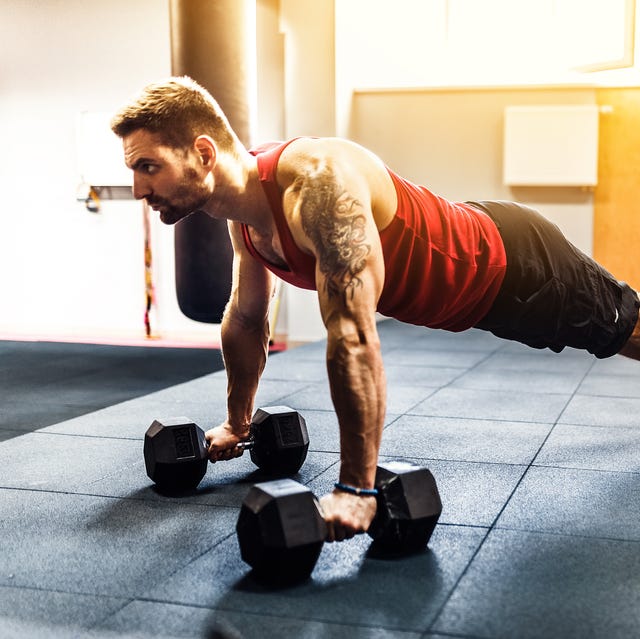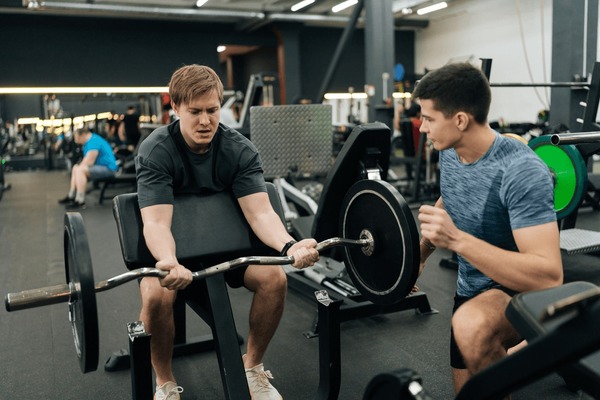Introduction: Your Key to a Stronger Body and Better Health
In the world of fitness, paths and programs are numerous, but the constant truth is that building strength and muscle begins with mastering the basics. It's not about complex exercises or fancy equipment, but about focusing on compound movements that engage the largest number of muscles simultaneously. These exercises, known as "Essential Exercises" or "Compound Movements", are the backbone of any effective training program, whether you are a beginner seeking to gain healthy muscle mass or an advanced athlete aiming to break strength barriers.
The pursuit of building strength is not just an aesthetic goal; it is an investment in your overall health. Increasing muscle mass improves your metabolism, strengthens bones and joints, reduces the risk of injuries, and even contributes to improving mood and cognitive functions. In this detailed article, we will delve deep into explaining 10 essential exercises that are indispensable on your journey toward building a strong and well-proportioned body, focusing on correct performance and practical tips to ensure maximum benefit and minimum risk of injury.
---
Detailed Explanation: The Ten Exercises That Form the Foundation of Strength
These ten exercises have been selected based on their effectiveness in stimulating muscle growth, increasing functional strength, and engaging multiple muscle groups in a single movement.
1. Squat
The Squat is undeniably the "King of Exercises." It is a natural movement that humans have performed since ancient times, and it primarily targets the lower body.
#### Targeted Muscles: Primary: Quadriceps, Glutes, and Hamstrings. Correct Performance: Stand with your feet shoulder-width apart, toes pointed slightly outward. Keep your back straight and your chest up. Begin to descend as if sitting in a chair, pushing your hips back until your thighs are parallel to the floor. Push through your feet to return to the starting position, squeezing your glutes at the top.
2. Deadlift
The Deadlift is one of the most powerful exercises for building overall strength, and it mimics the motion of lifting a heavy object from the ground.
#### Targeted Muscles: Primary: Lower back muscles (Erector Spinae), Glutes, Hamstrings, and Trapezius. Correct Performance: Stand over the bar with the middle of your feet directly underneath it. Bend your knees and grip the bar with a shoulder-width grip. Keep your back straight and tight, and your chest up. Begin the lift by pushing the ground away with your feet, keeping the bar very close to your body. When the bar reaches your knees, push your hips forward to complete the movement. Lower the bar slowly along the same path.
3. Bench Press
This is the most important exercise for building upper body strength, especially the pushing muscles.
#### Targeted Muscles: Primary: Pectorals, Triceps, and Anterior Deltoids. Correct Performance: Lie on the bench with your eyes directly under the bar. Grip the bar slightly wider than shoulder-width. Retract your shoulder blades (pull them back and down). Lower the bar slowly to the middle of your chest. Push the bar forcefully upward until your arms are fully extended, keeping your feet firmly planted on the floor.
4. Overhead Press (Shoulder Press)
This exercise is the best for building strong and well-developed shoulders, and it contributes to vertical pushing strength.
#### Targeted Muscles: Primary: Deltoids, Triceps. Correct Performance: Stand straight with the bar resting on your upper chest. Brace your core and glutes to keep your torso stable. Push the bar directly overhead until your arms are fully extended. Lower the bar slowly and with control to the starting position.
5. Bent-Over Barbell Row
An essential exercise for building a thick and strong back, necessary for balance with chest exercises.
#### Targeted Muscles: Primary: Latissimus Dorsi, Middle Back muscles (Rhomboids), and Biceps. Correct Performance: Hinge forward at the hips with a slight bend in the knees, keeping your back straight. Pull the bar toward your lower chest or abdomen, focusing on squeezing your back muscles. Lower the bar slowly and with control. Avoid using momentum from your lower back.
6. Pull-Up
An upper-body pulling exercise that uses body weight, and is an excellent measure of relative strength.
#### Targeted Muscles: Primary: Latissimus Dorsi, Biceps, and Forearms. Correct Performance: Grip the bar with a slightly wider than shoulder-width, palms facing forward. Pull your body upward until your chin clears the bar level. Lower your body slowly and with control to the starting position.
7. Lunge
An excellent unilateral exercise for improving balance, strengthening the glutes, and correcting any muscular imbalances between the legs.
#### Targeted Muscles: Primary: Quadriceps, Glutes, and Hamstrings. Correct Performance: Take a large step forward with one leg. Lower your hips until the knee of the front leg is at a 90-degree angle, and the knee of the back leg is almost touching the floor. Push through your front foot to return to the starting position. Repeat the movement on the other leg.
8. Push-Up
A classic bodyweight exercise, very effective for building pushing strength and endurance in the upper body.
#### Targeted Muscles: Primary: Pectorals, Triceps, and Anterior Deltoids. Correct Performance: Start in a high plank position, with hands slightly wider than shoulder-width. Keep your body straight from head to heels. Lower your chest toward the floor by bending your elbows. Push forcefully to return to the starting position.
9. Plank
An indispensable isometric exercise for strengthening the deep abdominal muscles and the entire core, which is the foundation of stability and functional strength.
#### Targeted Muscles: Primary: Transverse and Rectus Abdominis, and Lower Back muscles. Correct Performance: Start in a position similar to a push-up, but rest on your forearms. Your elbows should be directly under your shoulders. Keep your body in a perfectly straight line, and tightly brace your core and glutes. Hold this position for as long as possible while maintaining correct form.
10. Farmer's Walk
A simple yet incredibly effective exercise for increasing grip strength, strengthening the core muscles, and improving overall endurance.
#### Targeted Muscles: Primary: Forearms (Grip), Trapezius, and Core muscles. Correct Performance: Hold two heavy weights (dumbbells or kettlebells) in each hand. Stand straight, pulling your shoulders back and down. Keep your back straight and your core tight. Walk with natural, controlled steps for a specified distance or time.
---
Summary Table of Essential Exercises
| Exercise | Primary Muscle Group | Movement Type | Core Benefit |
|---|---|---|---|
| :--- | :--- | :--- | :--- |
| <strong>Squat</strong> | Glutes and Thighs | Push | Lower body strength and muscle mass |
| <strong>Deadlift</strong> | Lower Back and Hamstrings | Pull | Overall strength and back power |
| <strong>Bench Press</strong> | Chest and Anterior Shoulder | Push | Upper body strength and horizontal push |
| <strong>Overhead Press (OHP)</strong> | Shoulders | Push | Shoulder strength and vertical push |
| <strong>Bent-Over Row</strong> | Lats and Middle Back | Pull | Back strength and muscular balance |
| <strong>Pull-Up</strong> | Lats and Biceps | Pull | Relative strength and endurance |
| <strong>Lunge</strong> | Glutes and Thighs | Push | Balance and correcting imbalances |
| <strong>Push-Up</strong> | Chest and Triceps | Push | Upper body endurance strength |
| <strong>Plank</strong> | Core | Isometric | Core and back stability |
| <strong>Farmer's Walk</strong> | Grip and Core | Carry | Grip strength and functional endurance |
---
Practical Tips for Program Implementation and Maximum Benefit
Knowing the exercises is half the equation; the other half lies in how to apply them intelligently and effectively. Here is a set of practical tips that will help you achieve your goals in building strength and muscle:
1. Master Form Before Increasing Weight (Form Over Weight)
This is the golden rule you must adhere to. Never increase the weight at the expense of correct form. Incorrect performance not only reduces the effectiveness of the exercise but also significantly increases the risk of serious injuries.
Start Light: Use a light weight or even just your body weight initially to focus on mastering the movement. Record Yourself: Use your phone to record your performance from different angles to identify errors. Ask for Help: Do not hesitate to seek an assessment from a qualified trainer.
2. The Principle of Progressive Overload
Muscles only grow and become stronger when they are subjected to greater stress than they are accustomed to. This is the main driver of muscle growth.
#### Ways to Apply Progressive Overload: Increase Weight: This is the most common method. Add 2.5 kg to the bar when you can complete all sets and repetitions with correct form. Increase Repetitions or Sets: Try adding an extra repetition or set if you cannot increase the weight. Decrease Rest Time: Reduce the rest period between sets to increase the intensity of the workout.
3. Nutrition and Recovery: Building Outside the Gym
The workout is the stimulus, but the actual growth happens during rest and recovery.
Protein is Key: Consume a sufficient amount of protein (about 1.6 to 2.2 grams per kilogram of body weight) to support the repair and growth of muscle fibers. Carbohydrates and Healthy Fats: Carbohydrates provide the necessary energy for intense workouts, and healthy fats are essential for hormone production. Quality Sleep: Ensure you get 7-9 hours of quality sleep every night, as most growth hormones and muscle repair occur during deep sleep.
4. Smart Variation and Avoiding Overtraining
Variation is necessary to avoid plateaus and stimulate muscles in new ways.
Vary Repetitions: Integrate periods of low repetitions (3-5 reps) to increase maximal strength, with periods of moderate repetitions (8-12 reps) to increase muscle size. Active Rest: On rest days, engage in light activities such as walking or yoga to help speed up recovery. Listen to Your Body: If you feel sharp pain or chronic fatigue, take an extra rest day. Overtraining hinders progress.
---
Conclusion: The Journey of Strength Begins with a Step
Building strength and muscle is a marathon journey, not a sprint. There are no magic solutions, but rather a consistent commitment to the fundamentals. The ten exercises we have reviewed here are your most effective tools for achieving a real and sustainable transformation in your body.
Always remember that success in fitness is measured by consistency, mastering form, and prioritizing recovery. Start today, stick to the basics, and you will find that the strength you build in the gym will positively reflect on every aspect of your life. Invest in these exercises, and you will reap the rewards of boundless strength, health, and confidence.



